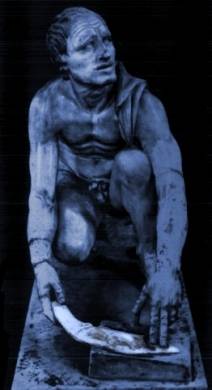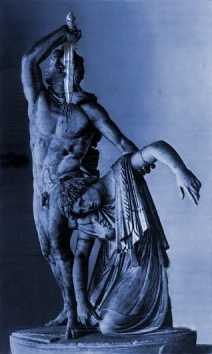|
|
 |
| First chronicled in the early 12th century, the story of the Knife Dancers is still bathed in a foggy mist. That said, we are now seeing a clearer picture of their music, due in large part to the research done at the University for Corporeal Studies, whose ethnomusicologists have traced current ritual paeans in the region to the ancient rites. On a macro-rhythmic scale, it appears that the phrased patterns of time actually germinated in the metronomic scrapings of the knife sharpeners [fig. 1], who toiled in dank workshops on the very implements that facilitated the pain and the passion of the participants. |
 |
| Fig. 1 Knife sharpener at work. |
| Though a great deal of variety existed, and still exists, in the instrumentation and form of the dances, one overriding feature common to all is the use of acceleratti to accentuate the frenzied exuberance. Not unlike the sufis, as the dance wore on, and the tempos increased, the numbers of fatigued dancers assisting others grew. With muscles spent and energy waning, many looked at the dangers of the knives as a dark blessing: the fresh exposure of the red blood brought excitement and a perverse sense of prestige, while at the same time the wielder might view an end to this life, for themselves or their depleted colleagues, as an inviting coda with a plagal cadence all it's own. Torn between ending their own misery or dispatching a friend or lover to the next world [fig.2], they made their decisions on the doorstep of exhaustion. |
 |
| Fig. 2 Saving a loved one while crossing over... |
| Through the work of Dr. Sebastian Wimple-Dorkworth, field recordings were made in the 1920's on cylinders. Virtually all of the instruments, constructed of indigenous materials, have long since disintegrated; none have been duplicated. Plucked string and percussive textures predominated, but the one piece of the fabric left to us today is the other-worldly keening of the singers. Many a listener has assumed (wrongly so) that the vocalisms must certainly have been made by a late 20th-century synthesizer, and yet vocalists, some even of the rare island castratto mutilation, continue to practice these melismatic ululations in earnest.
Thanks to progress in the wireless world, we are able to hear some of these very recordings. If you have RealAudio installed, you may listen to a sample just by clicking here, or you may listen to or download an mp3 version by clicking here. More work will need to be done to document this fascinating tributary of pathos, exhibitionism and aerobics; it is hoped that exposure such as this, and the article entitled "All Colors Mixed Turn Black", by Dr. Alexi Massingill of B'tuff College, will lead to a renewed interest (and grant support) to further this cause. After all, they shoot horses, don't they? |
| · f i n i s · |